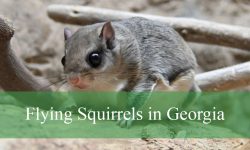Beetles are among the most diverse and fascinating insects on the planet, with over 350,000 species identified worldwide. Their incredible variety in size, shape, color, and behavior makes them a captivating subject for both scientists and nature enthusiasts. In this article, we will explore 45 types of beetle insects, providing detailed descriptions and identification tips to help you recognize these amazing creatures.
The types of beetle insects covered here range from the familiar ladybugs and Japanese beetles to less commonly known species like the rhinoceros beetle and bark beetle. Each beetle plays a unique role in its ecosystem, from pollination and decomposition to acting as natural pest controllers. Understanding the different types of beetle insects can deepen your appreciation for their importance and diversity.
For gardeners, students, and insect lovers alike, this guide to 45 types of beetle insects offers valuable knowledge to identify them in the wild or in your own backyard. With vivid descriptions and helpful identification pointers, readers will gain insight into their habits, habitats, and fascinating adaptations.
Different Types of Beetle Insects
Ladybug (Coccinellidae)
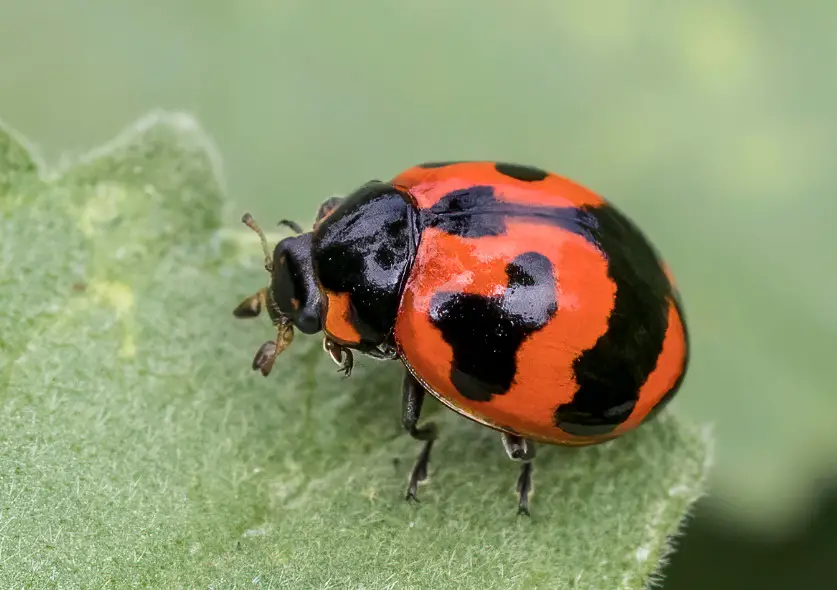
Ladybugs, also known as ladybirds or lady beetles, are small, dome-shaped beetles belonging to the family Coccinellidae. Most species are brightly colored, with red, orange, or yellow elytra marked with distinctive black spots, making them easy to identify. Their rounded bodies and short legs give them a characteristic appearance, while their size typically ranges from 1 to 10 millimeters.
These beetles are well-known for their beneficial behavior in gardens and agricultural fields. Ladybugs are voracious predators of aphids, scale insects, and other soft-bodied pests, making them important natural pest controllers. When threatened, they can secrete a yellow fluid from their leg joints, which has a strong odor to deter predators.
Ladybugs inhabit diverse environments, including gardens, grasslands, forests, and agricultural fields. They are found worldwide, with the highest diversity in temperate and tropical regions. Many species migrate seasonally to overwinter in leaf litter, under tree bark, or even inside buildings.
Asian Lady Beetle (Harmonia axyridis)
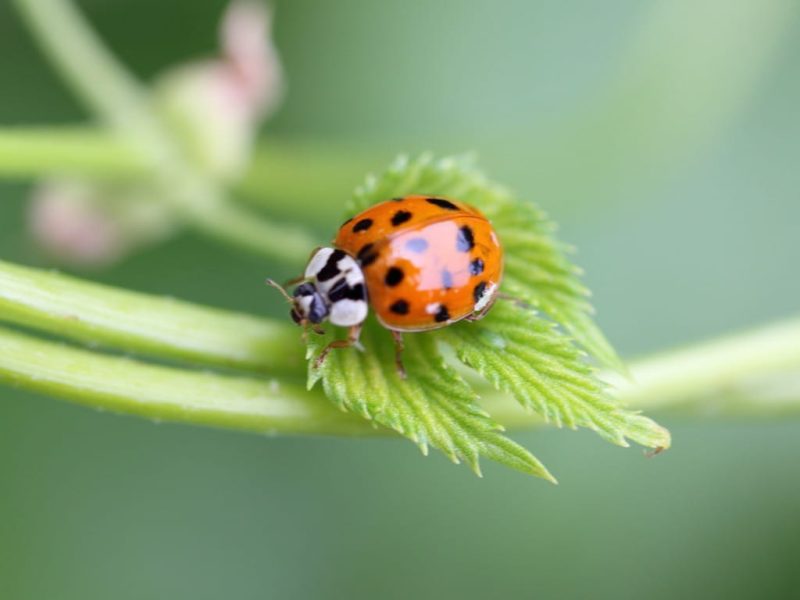
The Asian lady beetle is a large species of ladybug with a distinctive oval shape and smooth, shiny elytra. Its coloration varies widely, ranging from red and orange to yellow, with black spots that can be few or numerous. One identifying feature is the black M- or W-shaped marking on the white pronotum, just behind the head.
This species is highly adaptable and exhibits different behaviors compared to native ladybugs. While it feeds primarily on aphids and other plant pests, it can also become a nuisance indoors during autumn, as large groups gather to overwinter in homes. Unlike some native species, it may also prey on the eggs and larvae of other ladybugs.
Originally native to East Asia, the Asian lady beetle has been introduced to North America and Europe for pest control. It thrives in agricultural areas, gardens, orchards, and forest edges, showing a remarkable ability to colonize new regions.
Seven-spotted Ladybug (Coccinella septempunctata)
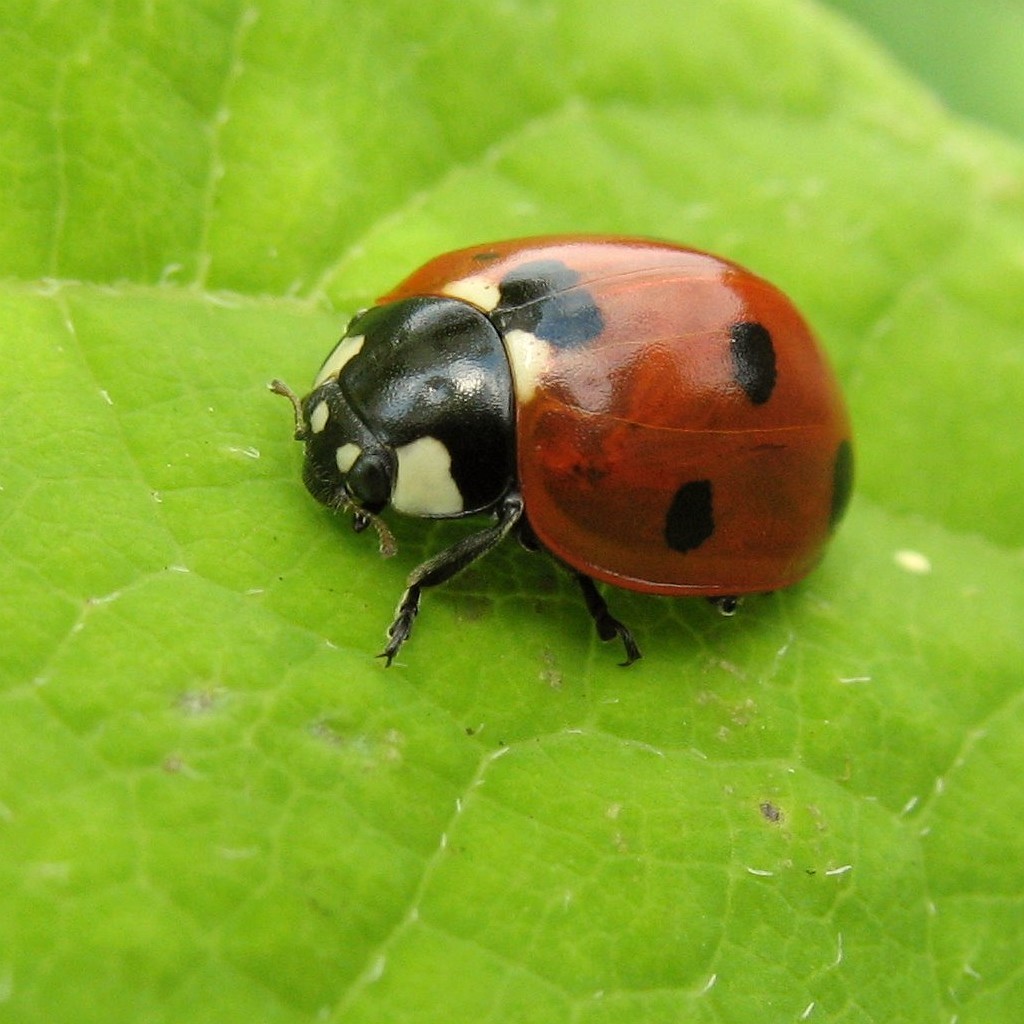
The seven-spotted ladybug is one of the most recognizable and common ladybugs in the world. Its bright red elytra feature three black spots on each side and one central spot near the midline, totaling seven. Its oval, slightly flattened body measures 7–10 millimeters, making it larger than many other ladybug species.
This ladybug is an active predator of aphids and is often introduced to crops for biological pest control. Both adults and larvae consume large numbers of plant pests, contributing significantly to natural pest management. When disturbed, they may reflexively bleed a bitter-tasting fluid from their legs to discourage predators.
Native to Europe and Asia, the seven-spotted ladybug has been introduced to North America, where it has established widespread populations. It inhabits meadows, crop fields, gardens, and forest edges, preferring areas with abundant aphid populations.
Colorado Potato Beetle (Leptinotarsa decemlineata)
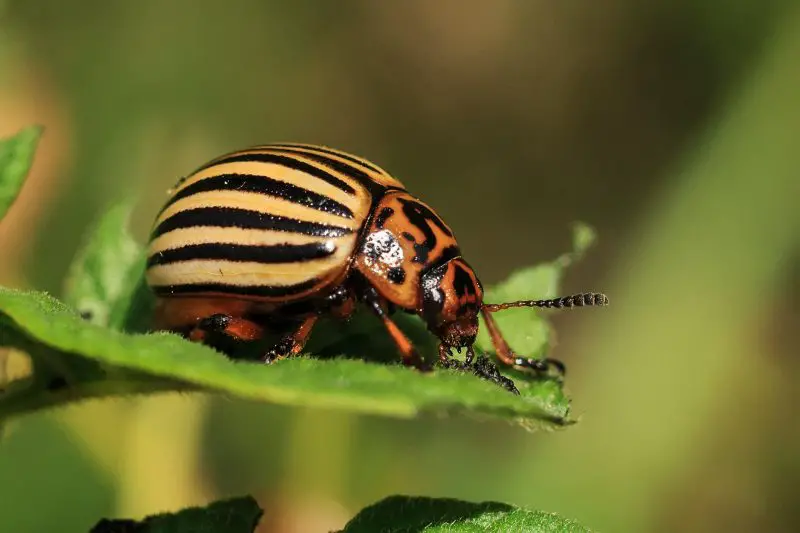
The Colorado potato beetle is a notorious agricultural pest easily recognized by its bright yellow-orange body with five bold black stripes running lengthwise on each elytron. Adults measure around 10 millimeters in length, and their robust, rounded shape makes them distinctive. The larvae are reddish with black spots along the sides.
This beetle is infamous for its destructive feeding habits on potato, tomato, and eggplant crops. Both adults and larvae consume large amounts of foliage, sometimes defoliating entire plants. Colorado potato beetles are also highly resistant to many insecticides, making them one of the most challenging pests for farmers to control.
Native to North America, the beetle originally fed on wild nightshades but adapted to cultivated potatoes as they spread across the continent. Today, it is found in North America, Europe, and parts of Asia, thriving in agricultural fields where its host plants are grown.
Japanese Beetle (Popillia japonica)
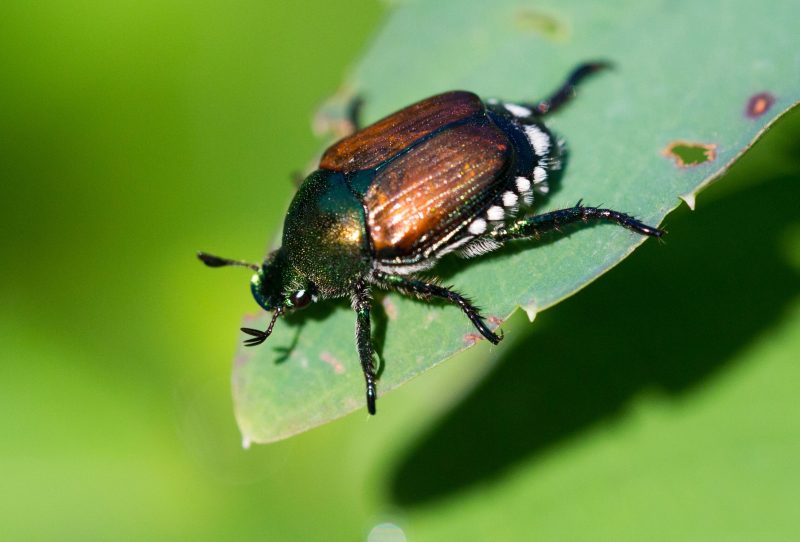
The Japanese beetle is a metallic green and coppery-bronze beetle, measuring about 10–12 millimeters in length. Its shiny elytra and distinctive white tufts of hair along the sides of its abdomen help in easy identification. The adults have a compact, oval-shaped body and strong chewing mouthparts.
Japanese beetles are highly destructive, feeding on the leaves, flowers, and fruits of over 300 plant species. They skeletonize leaves, leaving only the veins, which can significantly weaken plants. The larvae, known as grubs, live in soil and feed on grass roots, damaging lawns and pastures.
Native to Japan, this species has become an invasive pest in North America and parts of Europe. It thrives in gardens, orchards, golf courses, and agricultural fields, particularly in areas with moist soil and abundant host plants.
Green June Beetle (Cotinis nitida)
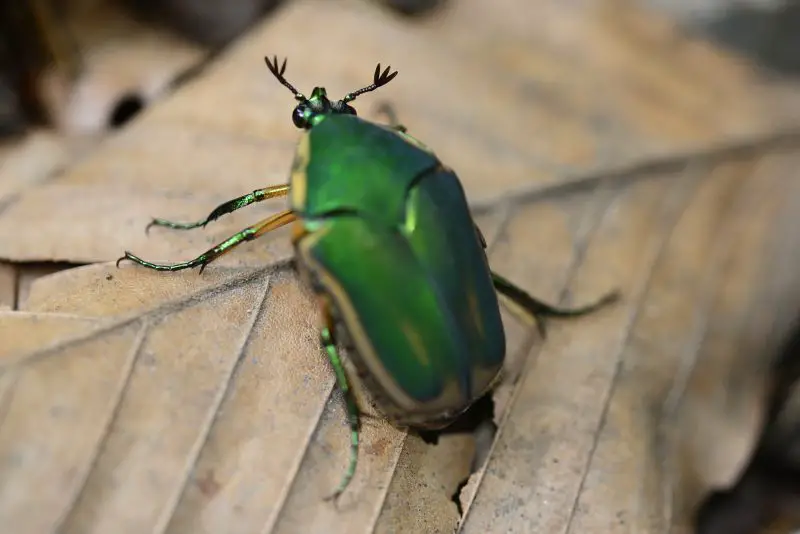
The Green June beetle is a large scarab beetle with a metallic green body and bronze or gold highlights on its wings and thorax. Adults typically measure 15 to 22 millimeters in length, with a robust, oval-shaped body. Their shiny appearance makes them easy to distinguish from other June beetle species.
These beetles are active during the day, feeding on ripened fruits such as peaches, grapes, and figs, as well as on flower nectar. The larvae, called white grubs, live in soil and feed on decaying organic matter and plant roots. Adults are strong fliers and can be seen buzzing loudly as they move between plants.
Native to the southeastern United States, the Green June beetle is commonly found in gardens, orchards, and pastures. They thrive in warm, humid environments and are most active in late spring and summer when fruits are abundant.
Rhinoceros Beetle (Oryctes nasicornis)
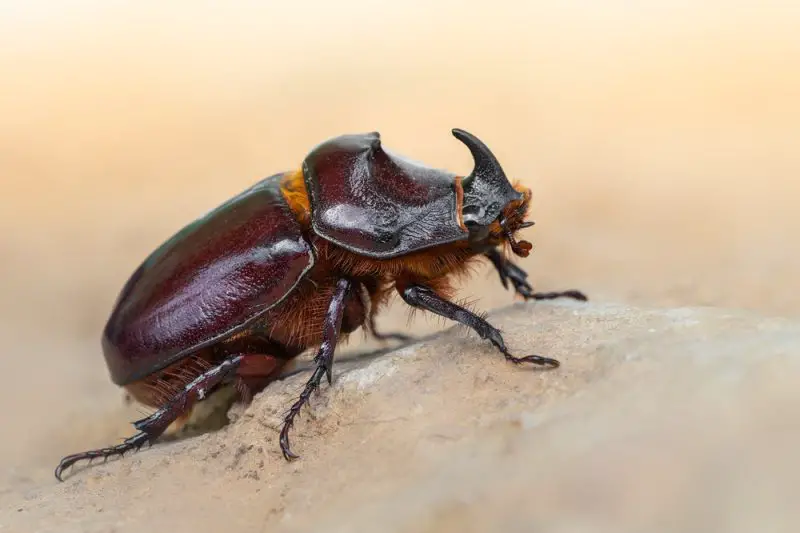
The Rhinoceros beetle is a large, powerful insect named for the horn-like projection on the males’ heads. Their bodies are dark brown to black, glossy, and heavily armored, with adults reaching up to 60 millimeters in length. Females are hornless, making it easy to distinguish between sexes.
These beetles are mainly nocturnal and are strong fliers despite their bulky bodies. Adults feed on plant sap and rotting fruit, while larvae consume decaying wood and organic matter. The horn is used by males during fights for mates, pushing and lifting rivals in impressive displays of strength.
Rhinoceros beetles inhabit forests, gardens, and agricultural areas, preferring regions with abundant rotting wood and decaying vegetation. They are found in Europe, Asia, and parts of Africa, playing an important ecological role in breaking down decomposing plant material.
Hercules Beetle (Dynastes hercules)
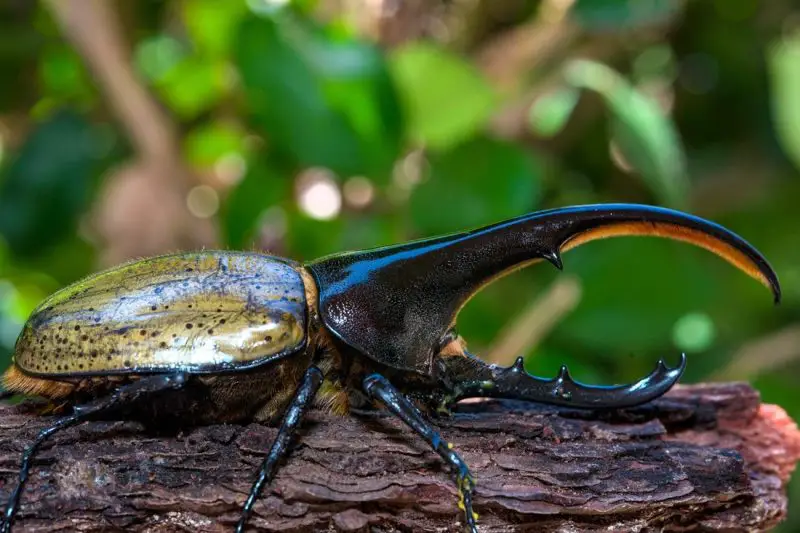
The Hercules beetle is one of the largest beetles in the world, with males reaching lengths of up to 170 millimeters, including their long, curved horns. Their elytra are typically greenish-yellow with black spots, while the horned males are easily distinguished from smaller, hornless females.
Males use their horns in combat, lifting and throwing rivals to compete for mates. Adults feed on rotting fruit and plant sap, while larvae develop in decaying wood, taking up to two years to mature. Despite their intimidating size, Hercules beetles are harmless to humans.
Native to the rainforests of Central and South America, Hercules beetles are most abundant in humid, tropical environments. They are often found in rotting logs, forest floors, and areas rich in decomposing vegetation.
Stag Beetle (Lucanus cervus)
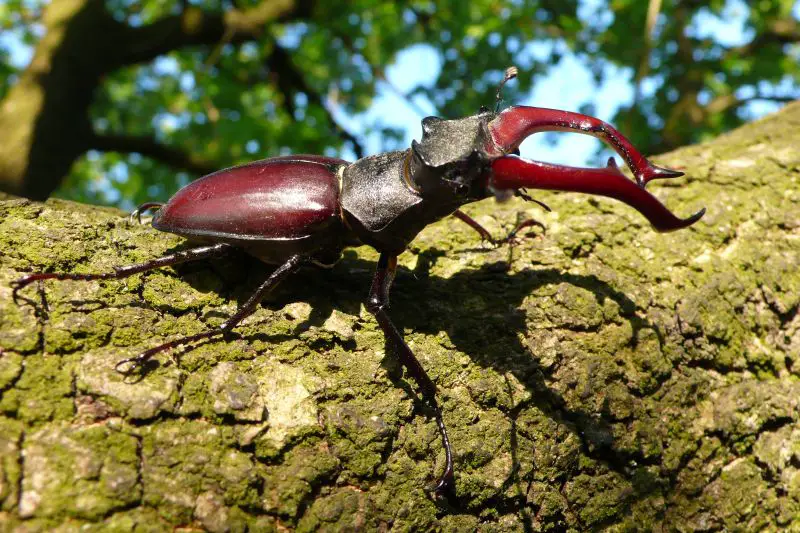
The Stag beetle is a striking beetle recognized by the large, antler-like mandibles of the males, which can be nearly as long as their heads. Their bodies are dark brown to reddish-brown, with shiny, hard exoskeletons. Females are smaller and have shorter mandibles.
Males use their oversized jaws to wrestle rivals during the mating season, lifting and tossing them in fights over females. Adults feed primarily on tree sap and decaying fruit, while larvae live in rotting wood for several years before emerging as adults.
Stag beetles are found in woodlands, gardens, and parklands across Europe, particularly in areas with old, decaying trees. They thrive in temperate climates and are most active on warm summer evenings.
Giant Stag Beetle (Dorcus titanus)
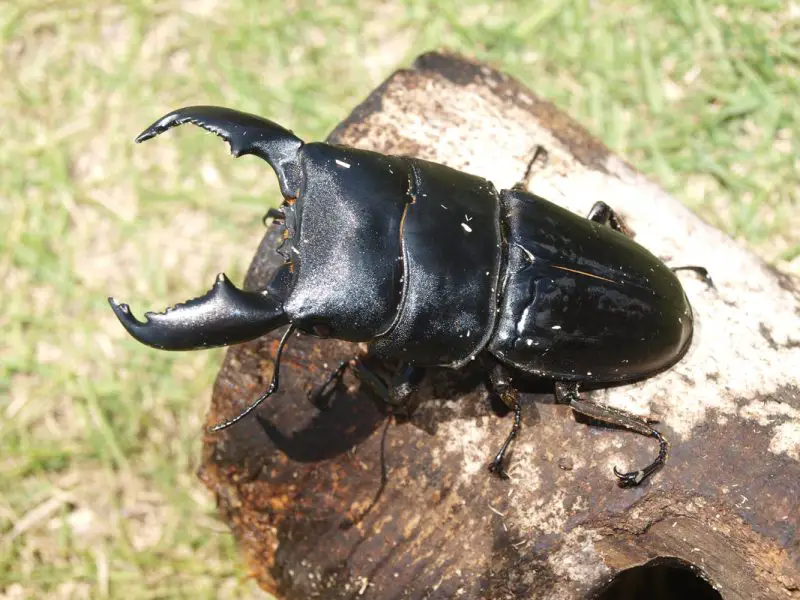
The Giant stag beetle, one of the largest members of the stag beetle family, is characterized by its elongated black body and massive mandibles in males. Adults can reach lengths of 110 millimeters, with shiny, smooth exoskeletons. Females are smaller with shorter jaws.
Like other stag beetles, males use their mandibles to fight for mates, engaging in dramatic battles. Adults feed on tree sap and decaying fruit, while larvae develop in rotting wood, often taking several years to complete their life cycle.
Native to Southeast Asia, the Giant stag beetle inhabits tropical and subtropical forests. It prefers humid environments with abundant decaying wood, where it plays an important role in breaking down organic matter.
Goliath Beetle (Goliathus goliatus)
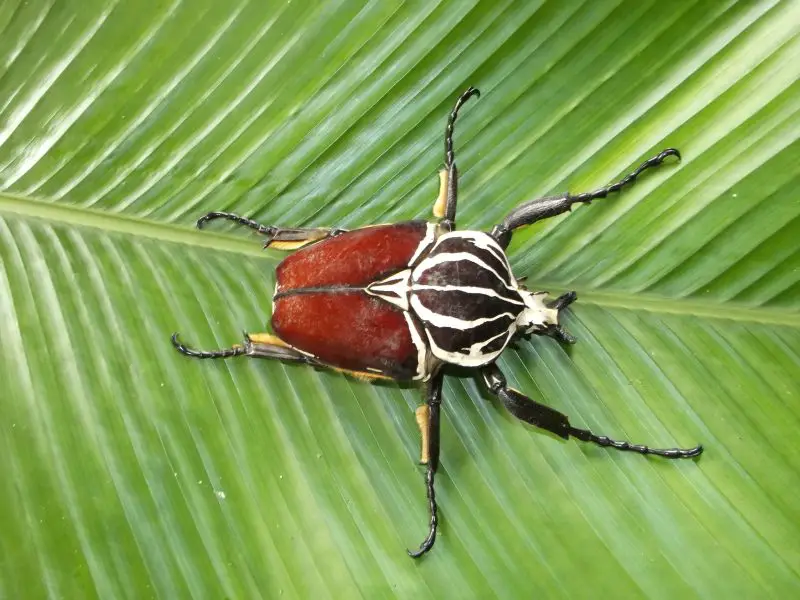
The Goliath beetle is one of the heaviest insects in the world, with adults weighing up to 100 grams. Their bodies are strikingly patterned, with a combination of black, white, and brown markings on the elytra. Males have a Y-shaped horn on their heads, while females lack this feature and have broader bodies.
These beetles feed primarily on tree sap and rotting fruit, using their strong mandibles to tear through tough plant material. The larvae are even larger than the adults, feeding on decaying wood and organic matter for several months before pupating. Despite their size, Goliath beetles are capable fliers.
Goliath beetles are native to tropical African rainforests, where they inhabit forest floors and rotting logs. They prefer warm, humid climates and play a vital role in breaking down decaying plant material.
Atlas Beetle (Chalcosoma atlas)
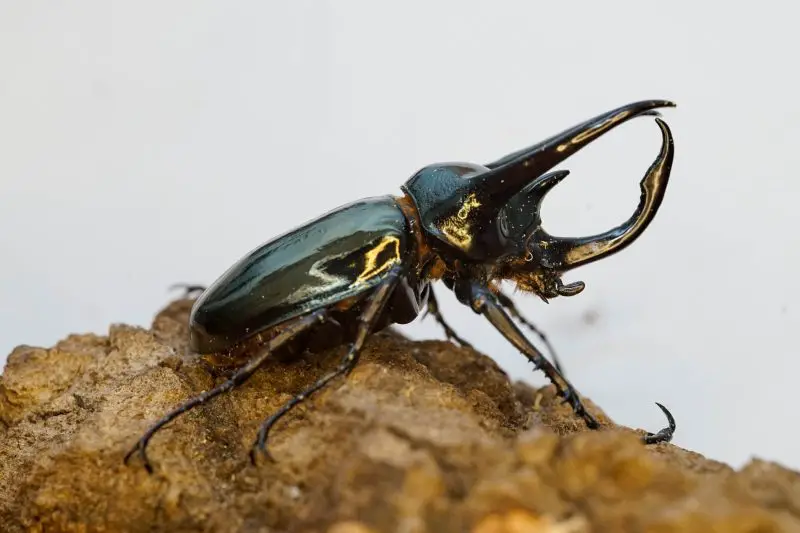
The Atlas beetle is a large rhinoceros beetle with impressive horns, particularly in males, where three prominent horns extend from the head and thorax. Their glossy dark brown to black bodies can reach lengths of 130 millimeters, making them one of the largest beetles in Asia.
Males are territorial and use their horns to battle other males for access to females, often lifting and throwing opponents. Adults feed mainly on fruit and plant sap, while larvae consume decaying wood and leaf litter. They are known for their strong grip and powerful legs.
This species is found in Southeast Asia, particularly in Malaysia, Indonesia, and Thailand. It thrives in tropical rainforests with abundant rotting wood and organic debris, contributing to forest nutrient cycling.
Elephant Beetle (Megasoma elephas)
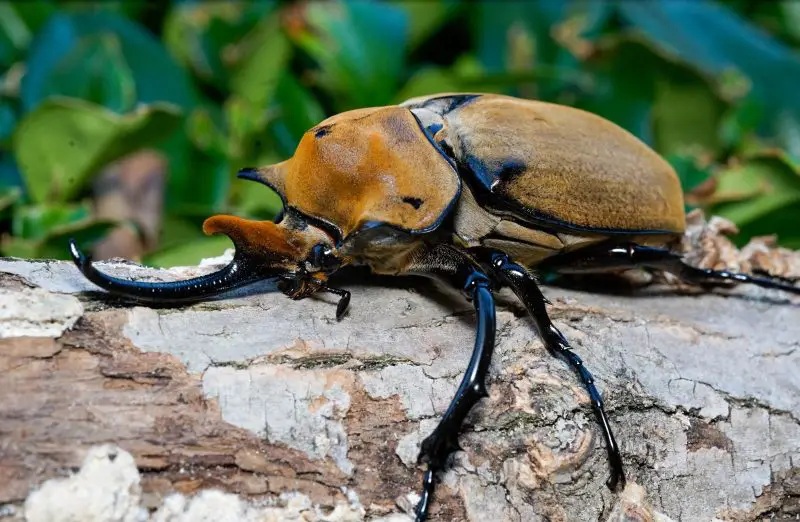
The Elephant beetle is a massive scarab beetle characterized by its large size and horned males. Males possess a long central horn on the head and two smaller horns on the thorax, resembling an elephant’s trunk, which gives the species its name. Adults are dark brown to black with a velvety texture.
Males use their horns in combat to compete for females, engaging in pushing and lifting battles. Adults feed on sap, nectar, and rotting fruits, while the larvae live in decomposing wood, taking up to three years to develop fully before pupating into adults.
Elephant beetles are native to Central and South American rainforests, particularly in Mexico, Costa Rica, and Brazil. They inhabit forest floors and rotting logs, playing an essential role in decomposing plant material.
Flower Chafer (Cetoniinae)
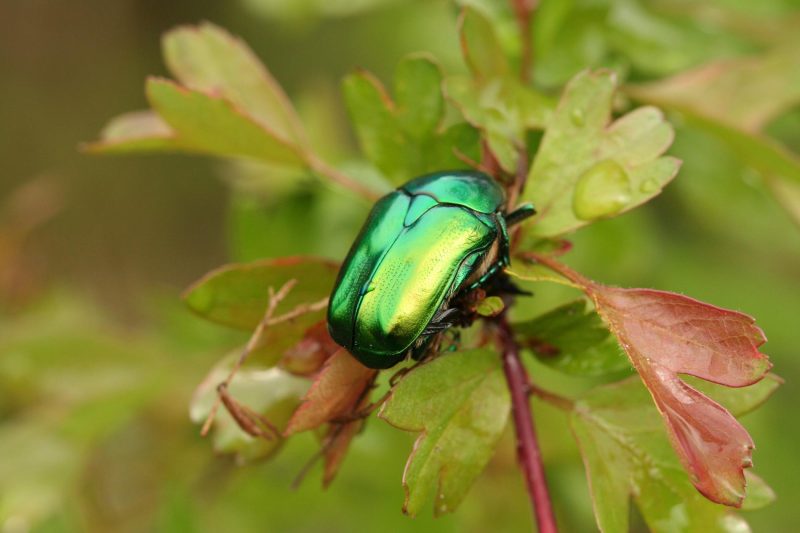
Flower chafers are medium to large scarab beetles with bright metallic colors, including green, gold, and bronze. They have smooth, streamlined bodies, allowing them to move quickly among flowers. Their unique clubbed antennae help them locate floral scents.
Unlike many other scarab beetles, flower chafers are diurnal and are often seen flying during the day. Adults feed on pollen, nectar, and fruit, sometimes causing damage to flowers and crops. The larvae develop in decaying wood or compost, contributing to nutrient recycling.
Flower chafers are found in tropical and subtropical regions worldwide, including Africa, Asia, and South America. They thrive in gardens, meadows, and forest edges where flowering plants are abundant.
Cotton Boll Weevil (Anthonomus grandis)
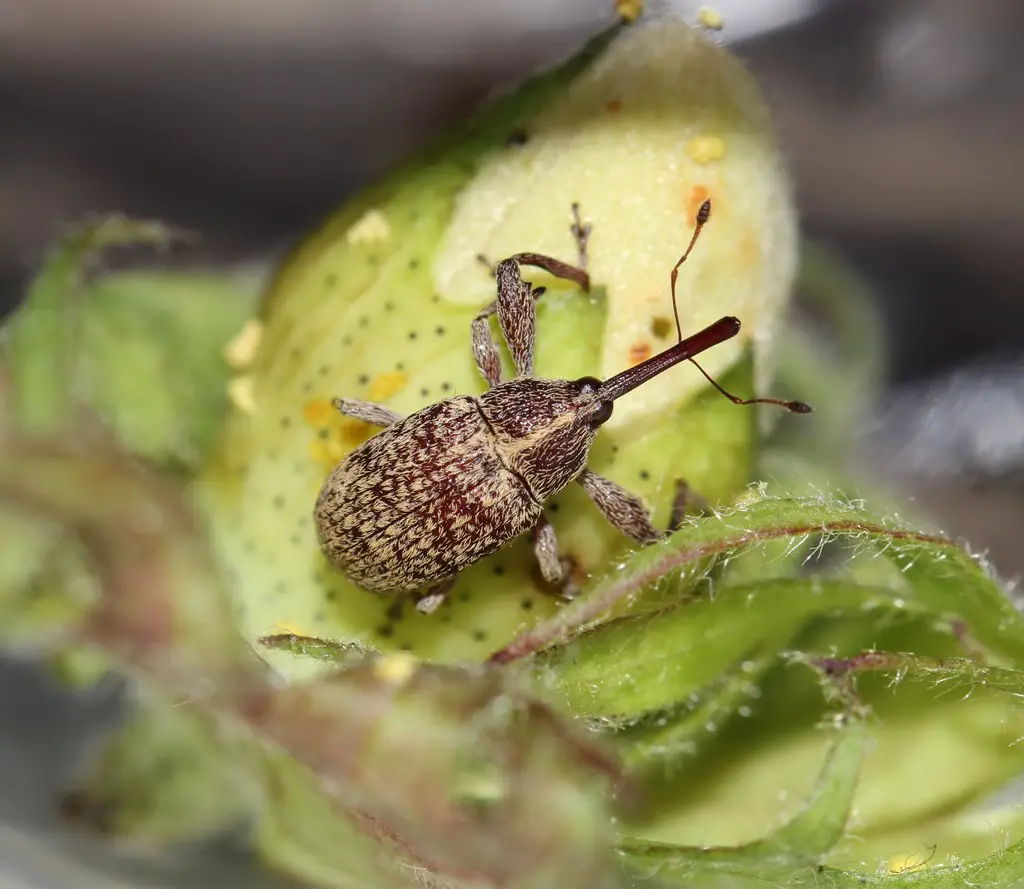
The Cotton boll weevil is a small grayish-brown beetle measuring about 6 millimeters, with a long, curved snout used for boring into cotton buds. Its body is covered with fine hairs, and its elongated shape makes it easy to identify among cotton pests.
This beetle is a serious agricultural pest, as females lay eggs inside cotton buds and squares, where the larvae feed and develop. The feeding damage causes buds to drop prematurely, resulting in significant crop losses. Adults feed on young cotton shoots and migrate between fields during the growing season.
Native to Central America, the Cotton boll weevil spread throughout the southern United States, devastating cotton production in the 19th and 20th centuries. It thrives in warm, humid regions where cotton is grown.
Bark Beetle (Scolytinae)
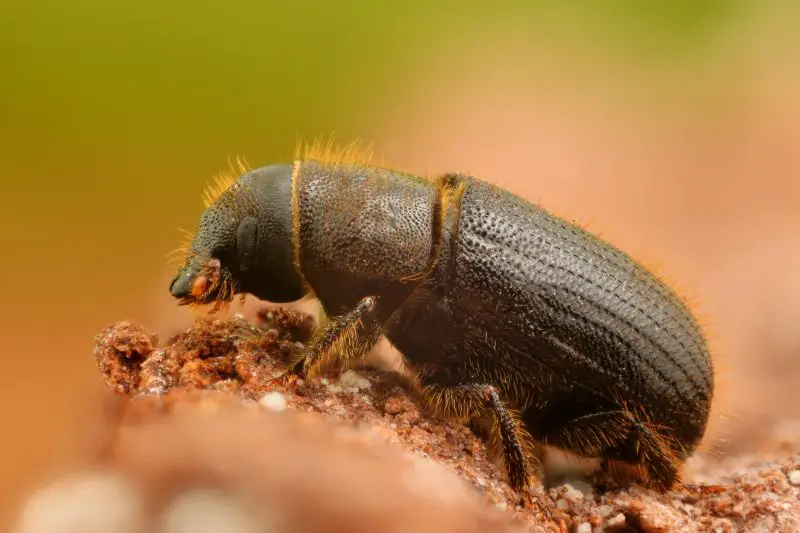
Bark beetles are small, cylindrical beetles, usually dark brown or black, measuring 3 to 6 millimeters in length. They are characterized by their compact bodies and clubbed antennae. Their hardened wing covers allow them to bore into the bark of trees, where they spend most of their life cycle.
These beetles are known for their destructive behavior, as adults and larvae feed on the inner bark of trees, disrupting nutrient flow. Many species carry fungi, including blue-stain fungi, which further weaken and eventually kill trees. They are most active during warm months and often attack stressed or weakened trees.
Bark beetles are distributed worldwide, particularly in coniferous and deciduous forests. They thrive in North America, Europe, and Asia, where they infest pine, spruce, and fir trees, especially in forested areas impacted by drought or fire.
Mountain Pine Beetle (Dendroctonus ponderosae)
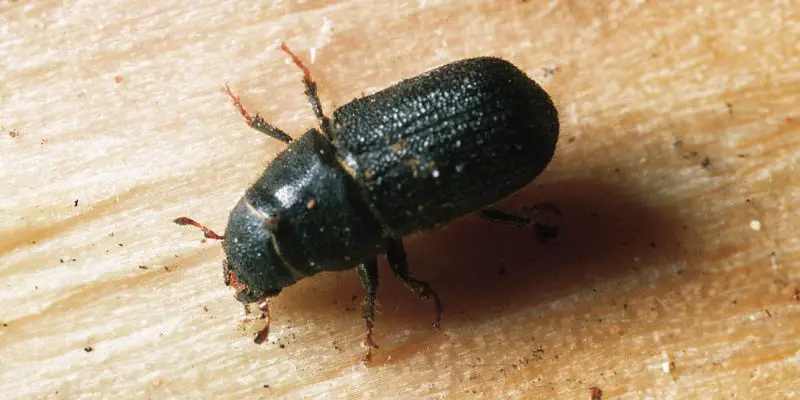
The Mountain pine beetle is a small, dark brown to black beetle, about 5 millimeters in length, with a hard, rounded body. Its smooth elytra and reddish-brown legs help distinguish it from other bark beetles. Despite its small size, it is considered one of the most destructive forest pests.
Adults bore into pine trees, where females lay eggs beneath the bark. The larvae feed on the inner bark, cutting off the tree’s water and nutrient supply. Additionally, they introduce blue-stain fungi that hasten the tree’s death. Massive infestations can wipe out large pine forests.
Native to western North America, the Mountain pine beetle thrives in coniferous forests, especially those dominated by lodgepole, ponderosa, and whitebark pines. It is most active during warm, dry summers, which facilitate rapid population growth.
Spruce Beetle (Dendroctonus rufipennis)
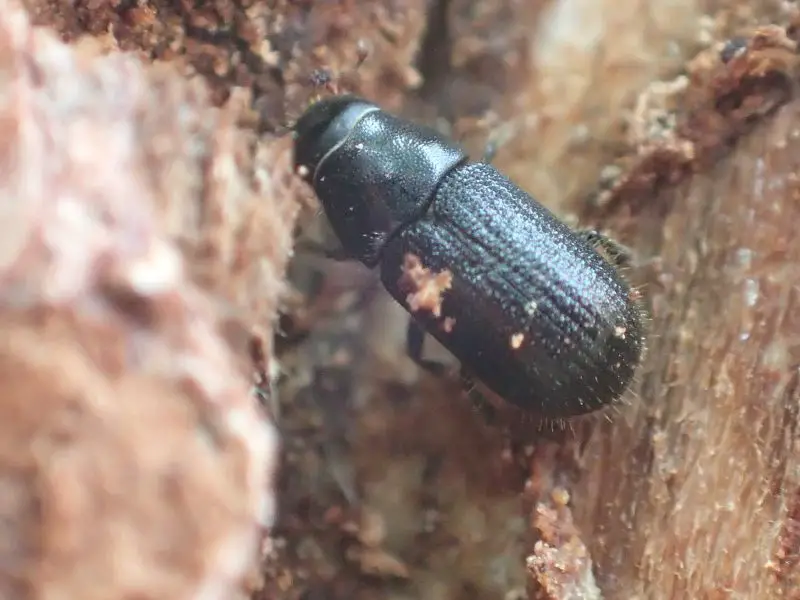
The Spruce beetle is a bark beetle that primarily infests spruce trees. Adults are reddish-brown to black, about 4 to 7 millimeters long, with cylindrical bodies. They bore into the bark of mature spruce trees, creating winding galleries for egg-laying.
Larvae feed on the inner bark, disrupting nutrient flow and eventually killing the host tree. Large infestations can destroy entire spruce forests, particularly after storms or other environmental stress weaken trees. Adults emerge in late spring and are active through summer.
This beetle is native to North America and is found across Canada and the northern United States. It thrives in boreal and montane spruce forests, especially in areas with abundant old or stressed trees.
Firefly Beetle (Lampyridae)
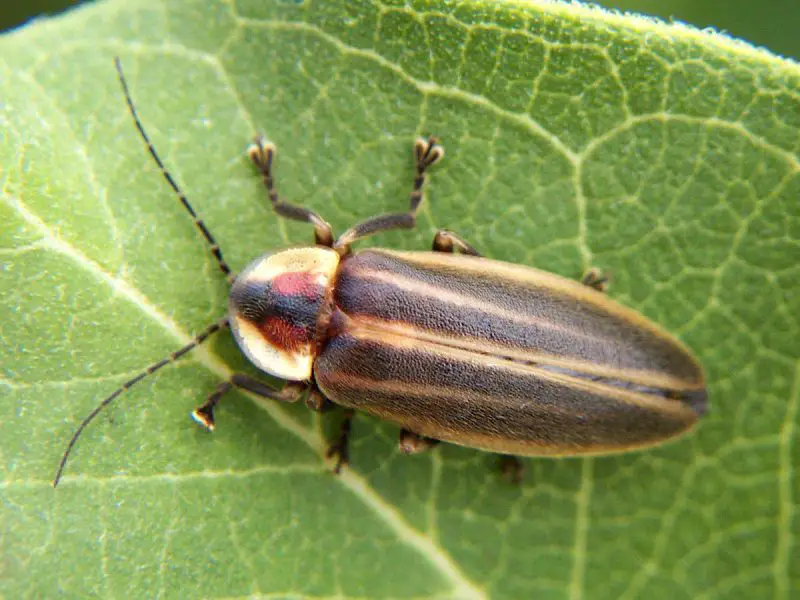
The Firefly beetle, commonly known as a lightning bug, is a soft-bodied beetle with a distinctive light-producing organ on its abdomen. Adults are usually brown or black with orange or yellow markings, and they range from 5 to 25 millimeters in length.
These beetles are famous for their bioluminescence, used for attracting mates and communicating. Different species flash unique light patterns. Larvae, known as glowworms, are predatory, feeding on snails, slugs, and other soft-bodied invertebrates, while adults may feed on nectar or pollen.
Fireflies are found in warm, humid regions worldwide, including North and South America, Asia, and Europe. They thrive in meadows, wetlands, and forest edges, preferring moist habitats that support their prey.
Soldier Beetle (Cantharidae)
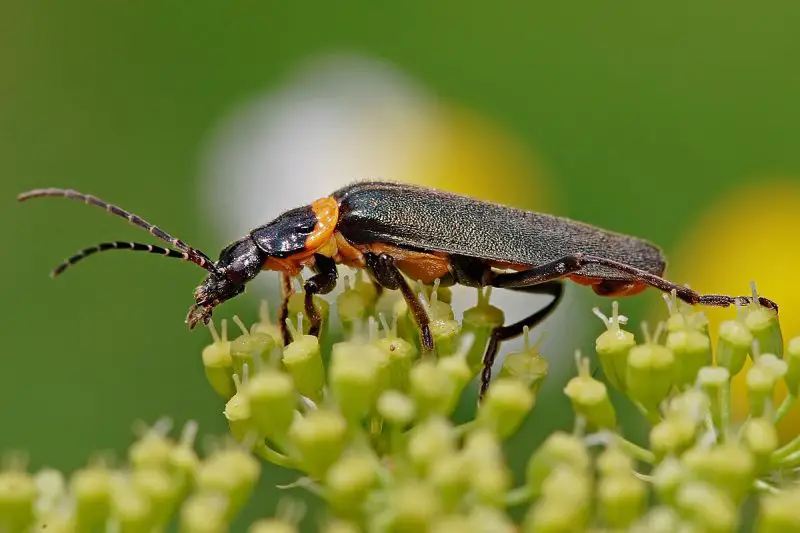
The Soldier beetle is a soft-bodied beetle with an elongated body, often brightly colored in shades of red, orange, or yellow with black markings. Adults typically measure 5 to 15 millimeters and resemble fireflies but lack light-producing organs.
Soldier beetles are beneficial insects, with adults feeding on nectar, pollen, and small insects such as aphids. Larvae are predatory, hunting caterpillars, grasshopper eggs, and other soft-bodied pests in the soil or leaf litter. They are active during the day and are often seen on flowers.
These beetles are found worldwide in gardens, meadows, and agricultural fields. They prefer areas with abundant flowering plants, which provide both food and mating sites.
Rove Beetle (Staphylinidae)
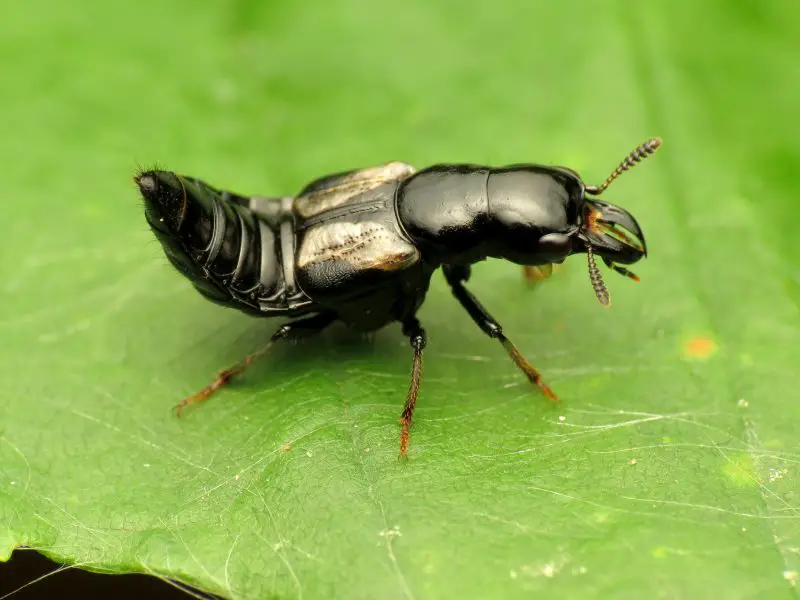
Rove beetles are slender, elongated beetles with very short elytra that leave more than half of their abdominal segments exposed. Their coloration varies from black and brown to metallic shades, and they typically measure 2 to 25 millimeters in length. Their flexible abdomen allows them to move quickly and curl defensively when threatened.
These beetles are highly predatory, feeding on other insects, mites, and decaying organic matter. Many species are beneficial to agriculture as natural pest controllers. Rove beetles are fast-moving and often found hunting under leaf litter, soil, or decaying wood.
Rove beetles are among the most widely distributed beetle families, found worldwide in forests, grasslands, wetlands, and agricultural fields. They thrive in moist environments with abundant organic material and prey.
Ground Beetle (Carabidae)
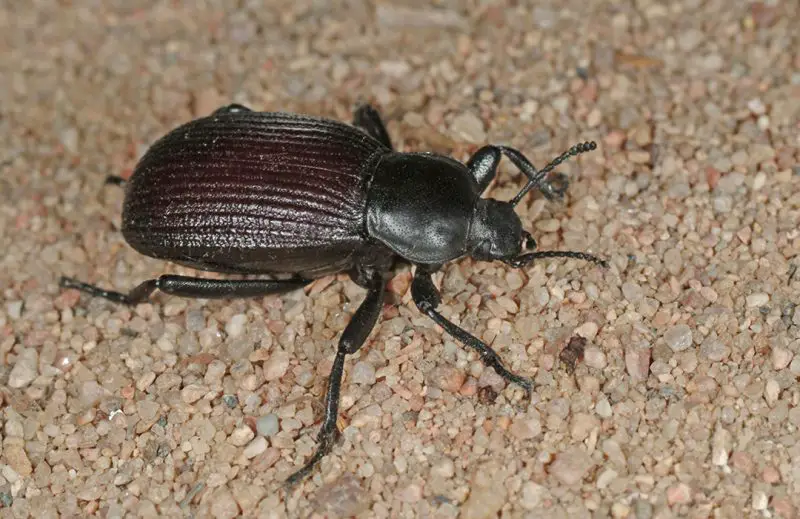
Ground beetles are dark, often shiny black or metallic-colored beetles with elongated, flattened bodies and long legs adapted for running. They typically range from 5 to 30 millimeters in size, with ridged elytra and prominent jaws.
Most ground beetles are nocturnal predators, feeding on caterpillars, slugs, and other soil-dwelling pests, making them valuable allies for farmers and gardeners. Some species are seed eaters, contributing to weed control. They are fast runners and rarely fly, preferring to hunt on the ground.
These beetles are found globally, inhabiting forests, fields, gardens, and riverbanks. They hide under rocks, logs, or leaf litter during the day and emerge at night to hunt.
Bombardier Beetle (Brachinus crepitans)
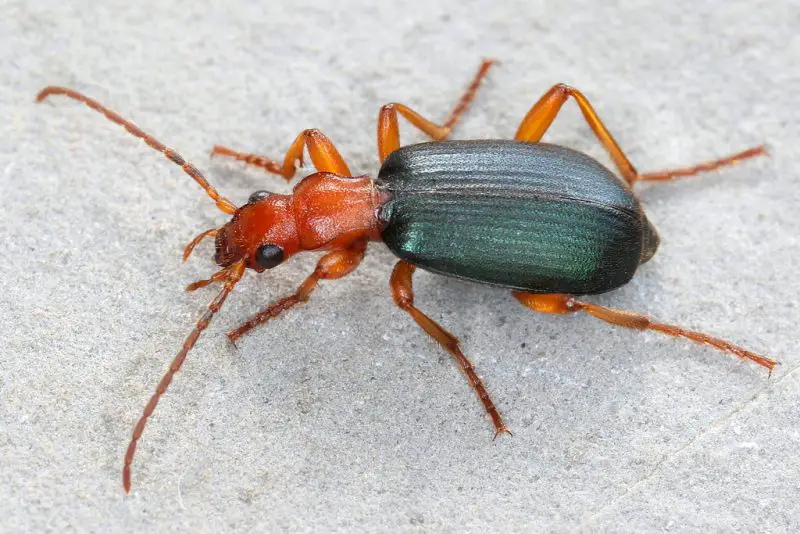
The Bombardier beetle is a small to medium-sized ground beetle, usually dark brown or black with orange or reddish markings on its head and thorax. It measures around 5 to 10 millimeters and has a compact, oval-shaped body.
This beetle is famous for its unique defense mechanism: it ejects a hot, noxious chemical spray from its abdomen with an audible pop when threatened. Bombardier beetles are predatory, feeding mainly on other small insects and larvae.
They are found in temperate and tropical regions worldwide, inhabiting soil, under rocks, and leaf litter. They prefer moist habitats such as riverbanks, wetlands, and forest floors, where prey is abundant.
Tiger Beetle (Cicindelinae)

Tiger beetles are brightly colored beetles with metallic green, blue, or bronze bodies and long, slender legs. Their large, bulging eyes and sickle-shaped mandibles make them fierce hunters. Adults range from 10 to 20 millimeters in length and are known for their incredible running speed.
Tiger beetles are active predators, chasing down and capturing small insects with precision. Larvae are also predatory, living in burrows and ambushing prey that passes by. Adults are diurnal and often seen darting quickly across sandy or bare soil surfaces.
They are found worldwide in sandy, open habitats, such as riverbanks, coastal dunes, grasslands, and desert areas. Tiger beetles are indicators of healthy ecosystems and are often studied in conservation biology.
Darkling Beetle (Tenebrionidae)
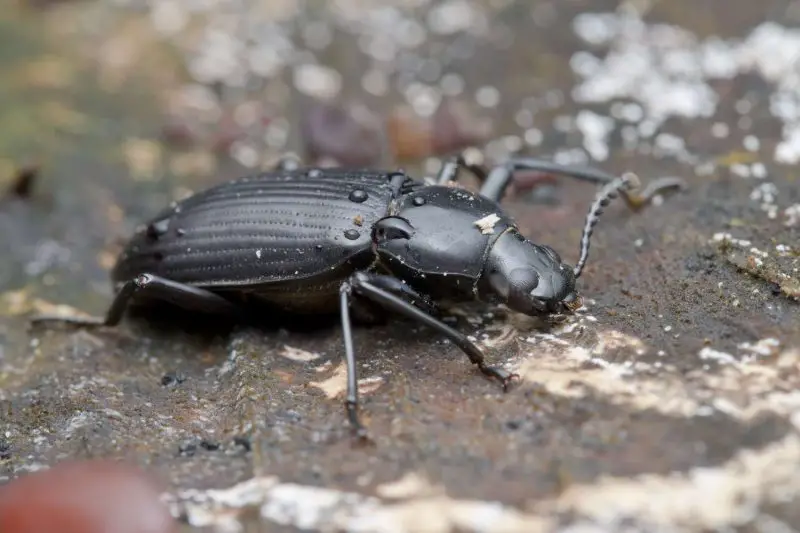
Darkling beetles are small to medium-sized beetles, usually dull black or brown, with elongated bodies and hard exoskeletons. Adults typically measure 5 to 20 millimeters and are easily identified by their lack of clubbed antennae and fused elytra, which prevent them from flying.
Most darkling beetles are scavengers, feeding on decaying plant material, seeds, and fungi. Some species, like the mealworm beetle, are known for their larvae, which are bred as food for reptiles and birds. They are mostly nocturnal and prefer dry habitats.
Darkling beetles are found worldwide, especially in deserts, grasslands, and arid regions. They are well adapted to dry environments, with some species capable of absorbing moisture from food to survive without water.
Mealworm Beetle (Tenebrio molitor)
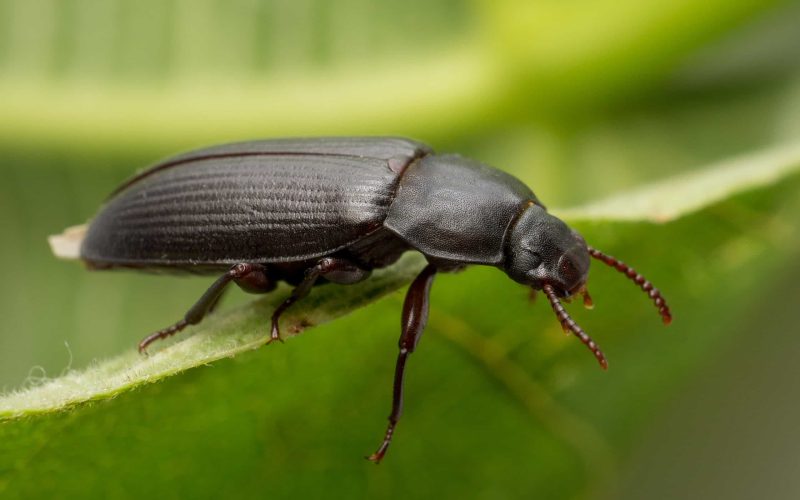
The Mealworm beetle is a dark brown to black beetle with an elongated, slightly flattened body, measuring about 12 to 18 millimeters in length. Adults have hard, smooth elytra with fine longitudinal lines. The larvae, known as mealworms, are yellowish-brown and worm-like, growing up to 25 millimeters.
These beetles are scavengers, feeding on grains, flour, and decaying plant material. Mealworms are widely used in animal feed, serving as a protein-rich food source for birds, reptiles, and fish. Adults are nocturnal and often found hiding in dark, dry areas during the day.
Mealworm beetles are found worldwide, especially in stored grain facilities, mills, and dry food storage areas. They thrive in temperate and warm regions, where they reproduce rapidly in dry, protected environments.
Red Flour Beetle (Tribolium castaneum)
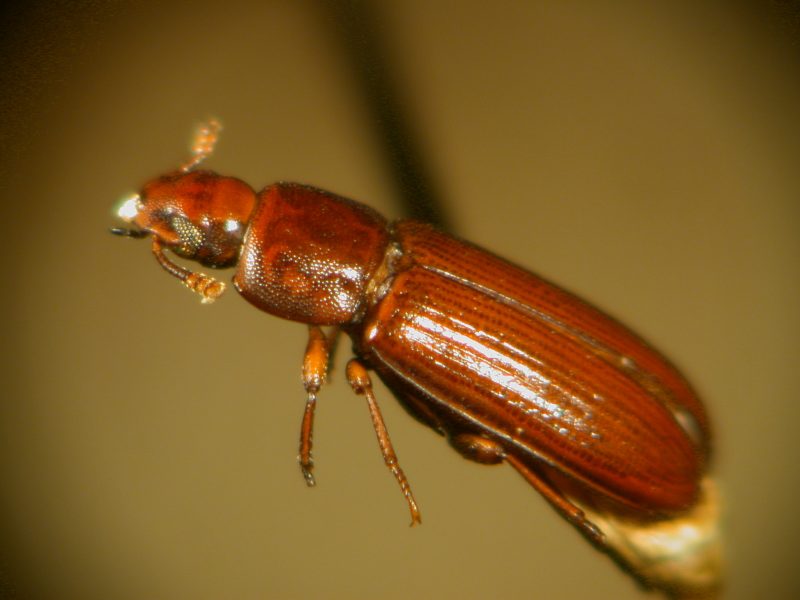
The Red flour beetle is a small reddish-brown beetle, about 3 to 4 millimeters long, with a flattened oval body. Its antennae end in a three-segmented club, and its wings allow it to fly short distances. It is easily distinguished from other flour beetles by its lighter red-brown coloration.
This beetle is a common pest of stored products, feeding on flour, cereals, spices, and dried foods. It does not feed on whole grains but infests broken or processed grains. Adults are long-lived, surviving up to three years under ideal conditions.
The Red flour beetle is cosmopolitan, occurring in warehouses, kitchens, and food storage facilities worldwide. It thrives in warm, humid conditions, making it a persistent pest in tropical and subtropical regions.
Black Carpet Beetle (Attagenus unicolor)
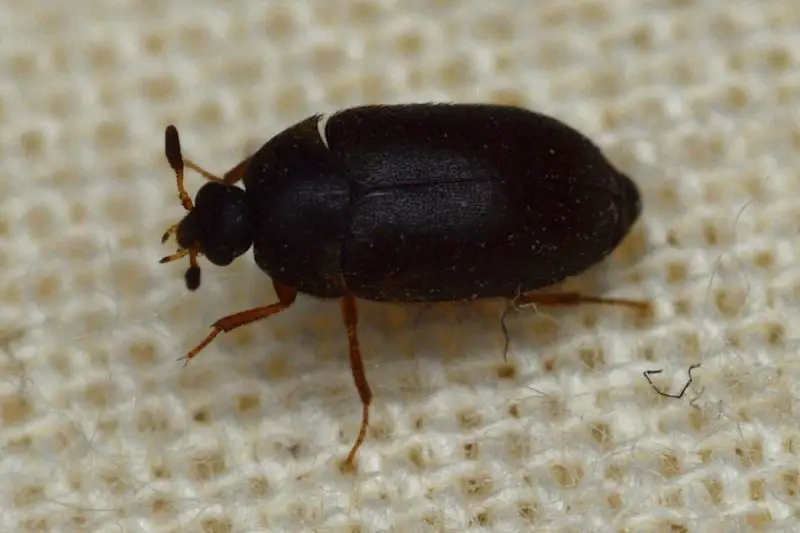
The Black carpet beetle is a small, oval beetle with a shiny black or dark brown body, measuring 3 to 5 millimeters in length. Adults have short antennae and fine hairs on their bodies, while larvae are elongated, brown, and covered with stiff bristles.
Larvae are destructive pests, feeding on natural fibers such as wool, fur, feathers, and stored products like grains and dried insects. Adults, however, primarily feed on pollen and nectar. Infestations often occur in carpets, clothing, and upholstered furniture.
Black carpet beetles are distributed worldwide, commonly found in homes, museums, and storage areas. They thrive in dry, dark locations, such as baseboards, closets, and attics.
Varied Carpet Beetle (Anthrenus verbasci)
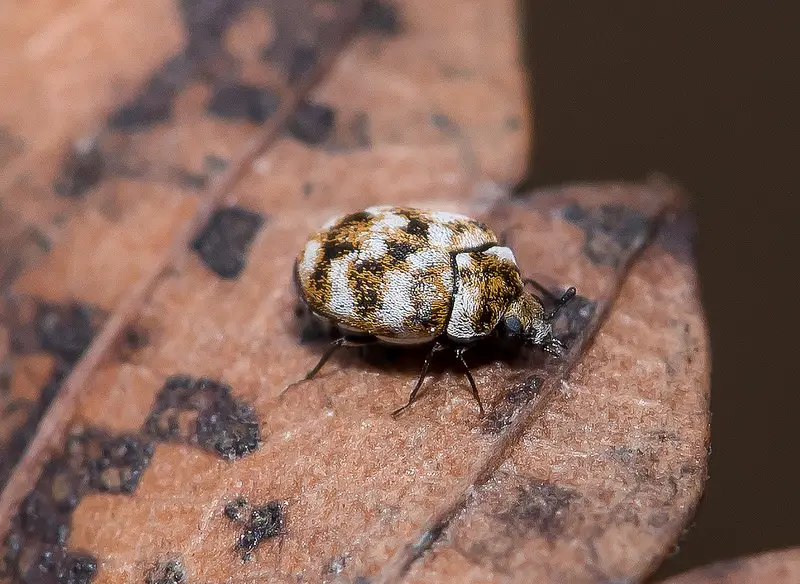
The Varied carpet beetle is a tiny, rounded beetle, 2 to 3 millimeters long, with mottled patterns of white, brown, and yellow scales on its elytra. Its small, compact shape and colorful markings distinguish it from other carpet beetles.
Larvae are notorious for damaging natural fibers, feeding on wool, silk, fur, feathers, and preserved specimens. Adults feed on pollen and nectar and are often seen near windows as they try to exit homes. Larvae can cause severe damage to carpets, clothing, and taxidermy collections.
This species is cosmopolitan, occurring in homes, museums, and warehouses worldwide. It thrives in dark, undisturbed areas, such as under carpets, furniture, and storage boxes.
Cigarette Beetle (Lasioderma serricorne)
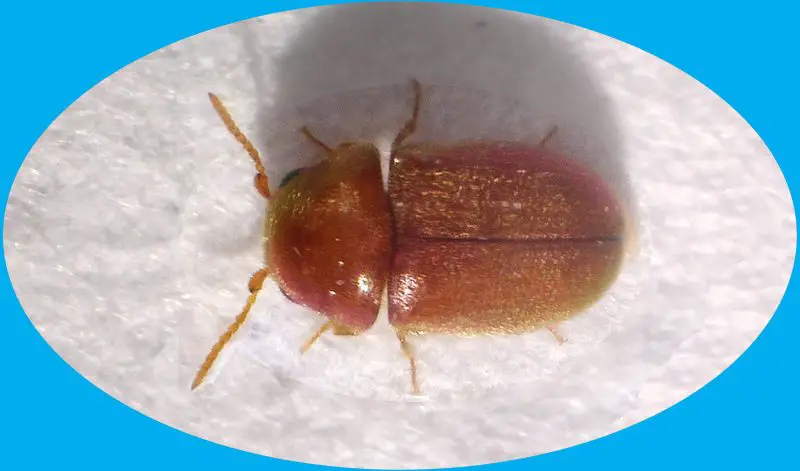
The Cigarette beetle is a small, reddish-brown beetle, about 2 to 3 millimeters long, with a humpbacked, oval body covered with fine hairs. Its head bends downward, giving it a characteristic hunched appearance.
This beetle is a major pest of stored products, especially tobacco, dried herbs, spices, cereals, and seeds. Adults are strong fliers and are attracted to light, while larvae bore into food products, causing contamination. Infestations can spread rapidly in warehouses and storage facilities.
Cigarette beetles are found worldwide, particularly in warm, humid regions. They thrive in tobacco warehouses, food storage areas, and pantries, where they reproduce quickly in suitable conditions.
Drugstore Beetle (Stegobium paniceum)
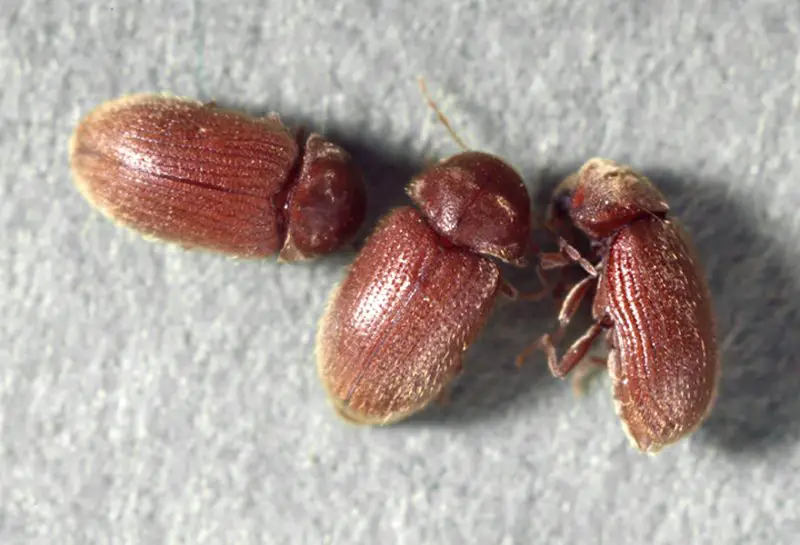
The Drugstore beetle is a small, reddish-brown beetle measuring about 2 to 3.5 millimeters in length. Its oval body is covered with fine hairs, and it has distinctive grooves running along its elytra. Its downward-bent head gives it a characteristic hunched appearance similar to the Cigarette beetle.
This beetle is a notorious pest of stored products, infesting flour, cereals, spices, dried herbs, and even pharmaceuticals, which gives it its common name. Both adults and larvae bore into packaging, contaminating food with frass. Adults are strong fliers and are often attracted to light.
Drugstore beetles are found worldwide, especially in warm, humid climates. They thrive in homes, warehouses, and food storage facilities, where they breed quickly and cause significant damage to stored goods.
Khapra Beetle (Trogoderma granarium)
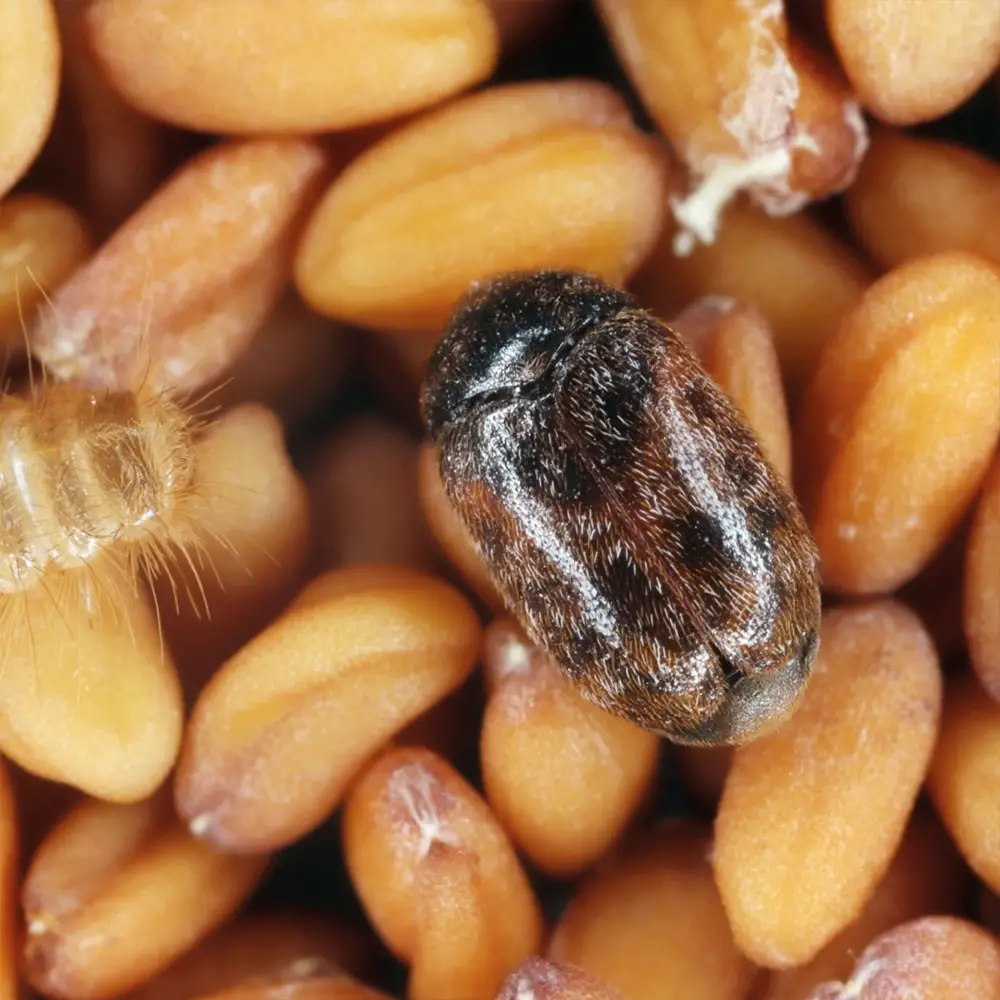
The Khapra beetle is a small, oval beetle, 1.6 to 3 millimeters long, with a reddish-brown to dark brown body covered in fine hairs. Larvae are golden brown with dense bristles and are more damaging than adults.
This beetle is one of the world’s most destructive stored-product pests. Larvae feed on grains, cereals, and other dry stored goods, causing weight loss and contamination with cast skins and hairs. Adults rarely feed, but infestations spread rapidly due to the beetle’s resilience and ability to survive long periods without food.
Native to South Asia, the Khapra beetle has spread to Africa, the Middle East, and parts of Europe. It thrives in hot, dry climates and is considered a serious quarantine pest in many countries.
Grain Weevil (Sitophilus granarius)
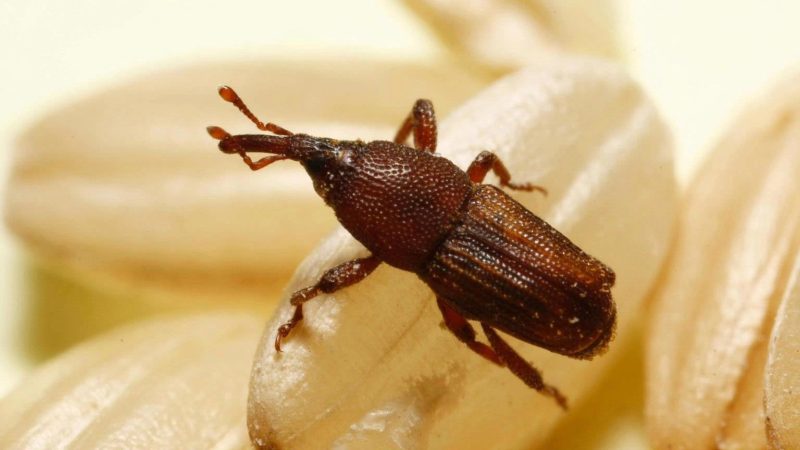
The Grain weevil is a small, dark brown to black beetle about 3 to 5 millimeters long, with a slender, elongated snout. Its wing covers have distinct longitudinal ridges, and unlike some other weevils, it cannot fly.
This beetle is a major pest of stored grain, boring into kernels where females lay eggs. Larvae develop inside the grain, hollowing it out and causing significant weight loss. Adults feed on whole grains, further reducing quality.
Grain weevils are found worldwide, especially in temperate regions where grains are stored. They thrive in granaries, silos, and food storage facilities, surviving long periods without fresh grain.
Rice Weevil (Sitophilus oryzae)
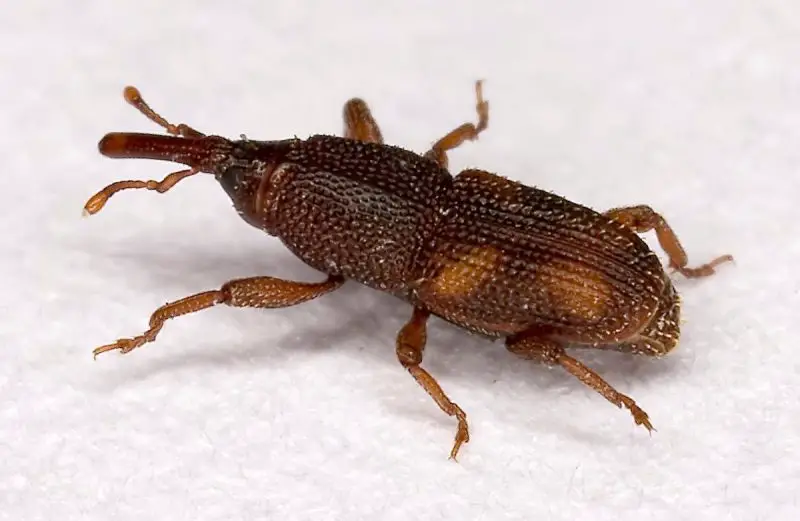
The Rice weevil is similar in appearance to the Grain weevil but slightly smaller, measuring 2 to 3.5 millimeters. It is reddish-brown to dark brown with four light reddish or yellowish spots on the elytra, which help distinguish it from other weevils.
This species is a serious pest of stored grains, especially rice, wheat, and corn. Females bore holes into grains to deposit eggs, and larvae feed inside, leaving hollow shells. Unlike the Grain weevil, adults can fly, aiding rapid spread.
Rice weevils are distributed worldwide, particularly in tropical and subtropical regions. They thrive in grain storage facilities, warehouses, and pantries where conditions are warm and humid.
Maize Weevil (Sitophilus zeamais)
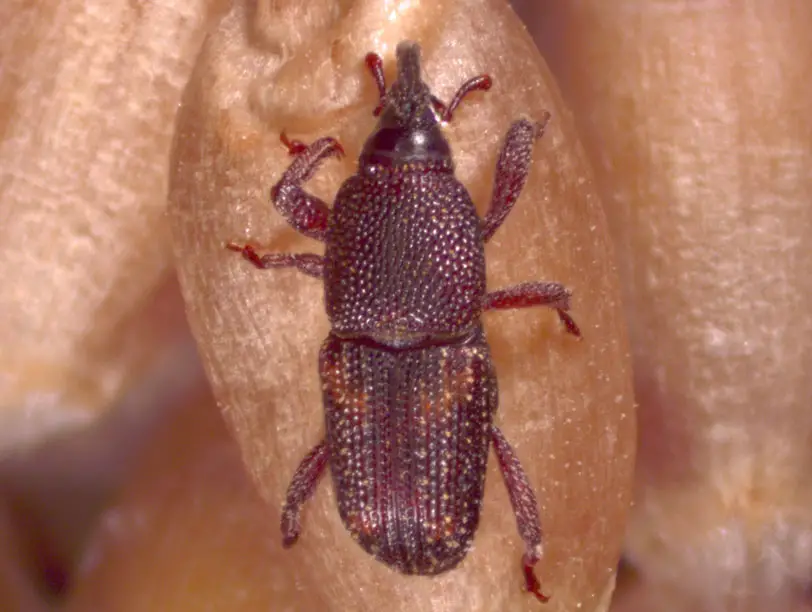
The Maize weevil closely resembles the Rice weevil, measuring 2.5 to 4 millimeters long, with a reddish-brown to dark brown body and faintly marked elytra. It has a slender snout and clubbed antennae typical of weevils.
This beetle attacks stored maize, wheat, rice, and sorghum. Females lay eggs inside kernels, and larvae develop within, causing extensive grain loss. Adults are strong fliers, contributing to rapid infestations in storage facilities.
Native to Central and South America, the Maize weevil has spread globally, thriving in warm, humid regions. It is commonly found in silos, warehouses, and other grain storage areas.
Pine Sawyer Beetle (Monochamus spp.)
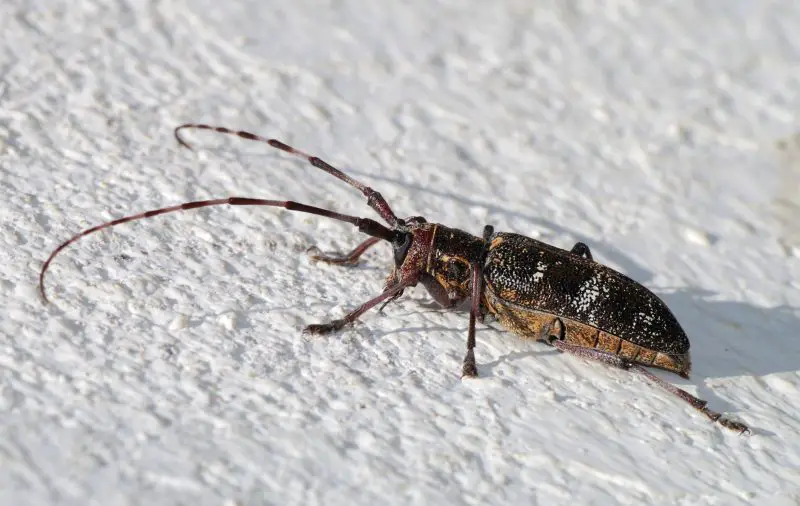
The Pine sawyer beetle is a large longhorn beetle, ranging from 12 to 25 millimeters in length, with a dark brown to black body often mottled with white or gray patches. Its most distinctive feature is its extremely long antennae, sometimes twice the body length.
Adults feed on pine bark and needles, while larvae bore deep into pinewood, creating long tunnels that weaken trees. These beetles are also vectors of the pinewood nematode, which causes pine wilt disease, making them significant forestry pests. Adults are strong fliers and are most active during warm months.
Pine sawyer beetles are found in coniferous forests across North America, Europe, and Asia. They thrive in areas with stressed, dying, or recently felled pine trees, where females lay eggs under the bark.
Longhorn Beetle (Cerambycidae)
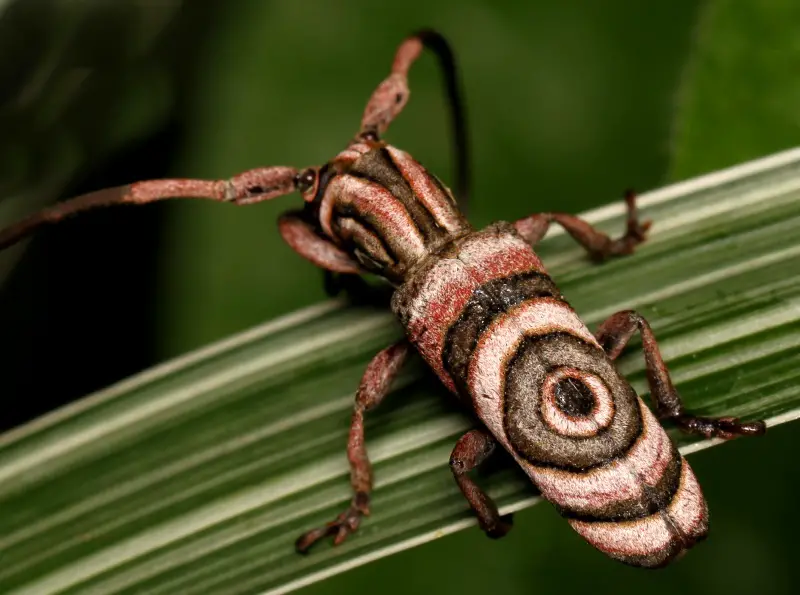
Longhorn beetles are a large family of beetles known for their extremely long antennae, which can exceed their body length. They vary greatly in size and color, from small brown species to large, brightly patterned ones, with adults typically measuring 10 to 150 millimeters.
Most species have wood-boring larvae that tunnel into trees, weakening or killing them. Adults feed on nectar, pollen, or bark, while some species are attracted to lights at night. Many longhorn beetles play important roles in decomposing dead wood, although some are serious pests of timber.
These beetles are distributed worldwide, inhabiting forests, grasslands, and woodlands. They are particularly diverse in tropical regions, where they help recycle nutrients by breaking down decaying wood.
Asian Longhorned Beetle (Anoplophora glabripennis)
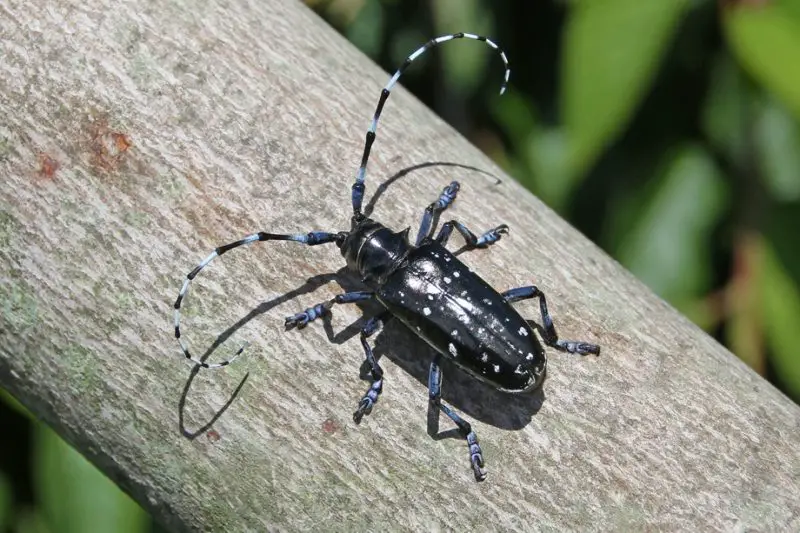
The Asian longhorned beetle is a striking black beetle with irregular white spots on its elytra and extremely long black-and-white-banded antennae. Adults typically measure 20 to 35 millimeters in length, making them easy to identify.
This species is a destructive pest of hardwood trees, boring into maples, elms, and willows. Larvae tunnel deep into trunks and branches, disrupting water flow and causing tree dieback or death. Adults emerge in summer, leaving round exit holes in bark.
Native to China and Korea, the Asian longhorned beetle has become an invasive species in North America and Europe. It thrives in urban and forested areas, where it poses a serious threat to native hardwood trees.
Cottonwood Borer (Plectrodera scalator)
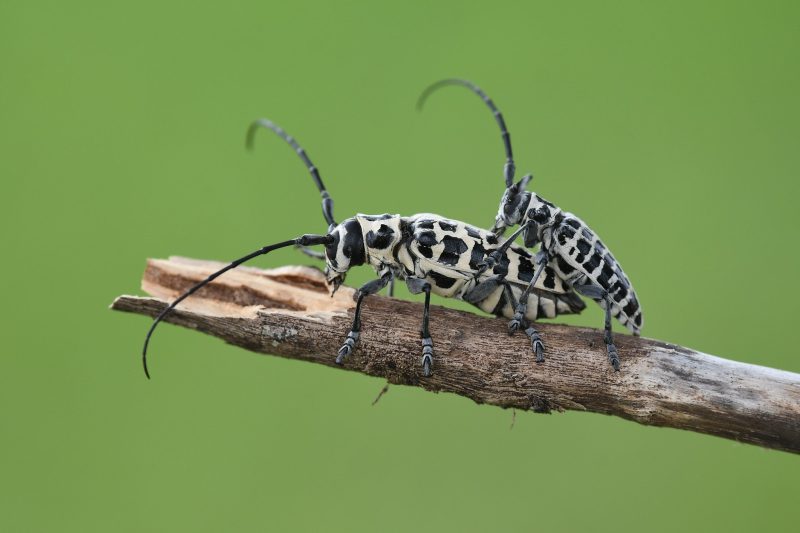
The Cottonwood borer is a large longhorn beetle, about 25 to 38 millimeters long, with striking black-and-white banded patterns on its body and long antennae. Its robust body and distinctive coloration make it easily recognizable.
Larvae bore into cottonwood and poplar tree trunks, feeding on wood and weakening structural integrity. Adults feed on leaves and twigs but cause less damage than the larvae. They are active in summer, often seen on host trees.
This species is native to North America, especially in the southern United States. It inhabits cottonwood groves, riverbanks, and floodplains where host trees are abundant.
Weevil Beetle (Curculionidae)
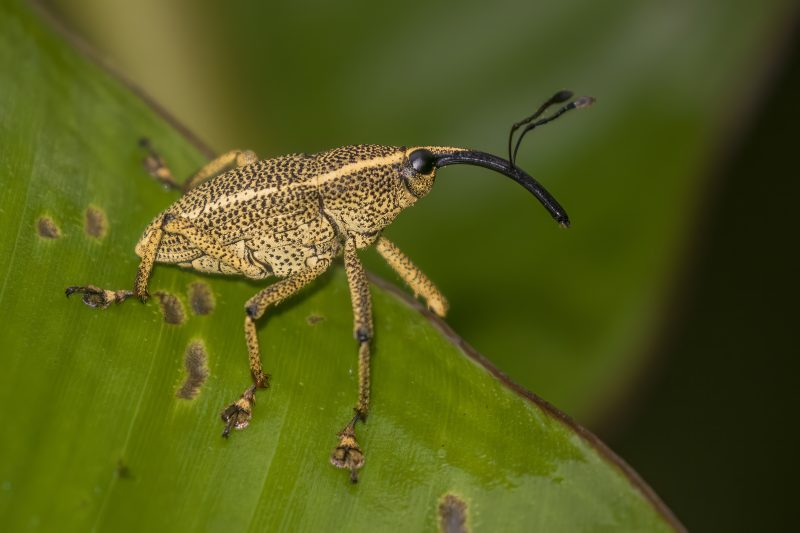
Weevil beetles are a diverse family of beetles characterized by their elongated snouts and clubbed antennae. They range in size from 2 to 30 millimeters and come in various colors, from dull brown to brightly patterned species.
Weevils are primarily plant feeders, with many species targeting seeds, grains, leaves, or stems. Some, like the boll weevil and grain weevil, are serious agricultural pests. Larvae typically develop inside plant tissues, causing internal damage.
Weevil beetles are found worldwide, inhabiting forests, grasslands, agricultural fields, and storage facilities. They thrive in warm, humid environments and are especially common in areas where crops or stored grains are plentiful.
Barked Beetle (Trypodendron lineatum)
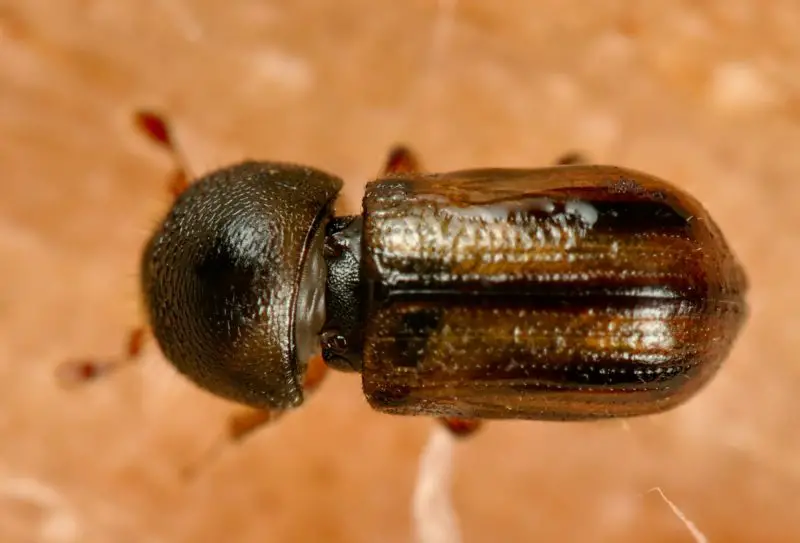
The Barked beetle is a small cylindrical beetle, typically measuring about 4 to 6 millimeters long, with a dark brown to black body covered by smooth elytra. It has short antennae and a compact shape adapted for boring under tree bark.
These beetles infest coniferous trees, especially pines and spruces, where the larvae tunnel beneath the bark feeding on phloem tissue. They often work symbiotically with fungi that help decompose wood, facilitating nutrient cycling. Adults typically emerge in spring to early summer.
Found primarily in North America and Europe, Barked beetles prefer forested areas with abundant conifers, particularly in stressed or dead trees following logging or storms.
Tortoise Beetle (Cassidinae)
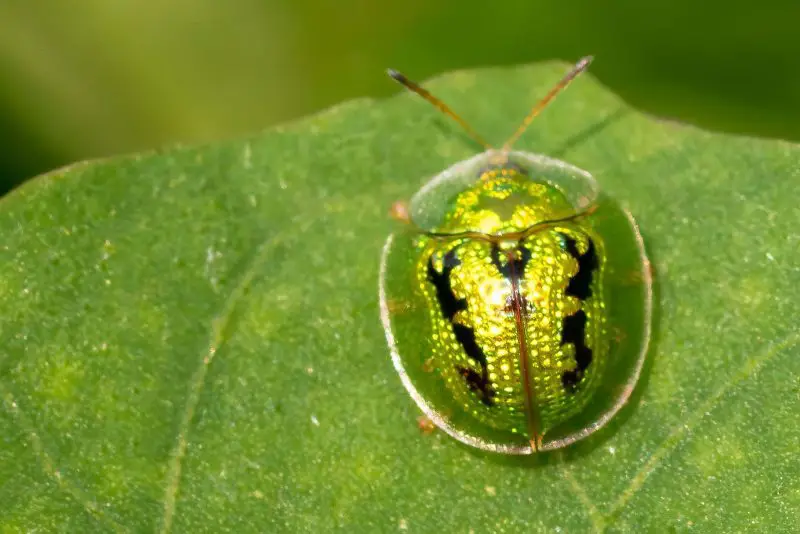
Tortoise beetles are small, rounded beetles, often less than 10 millimeters long, with domed, shield-like elytra that can be metallic or translucent. Their unique shape resembles a tortoise shell, and many species can change color slightly depending on their mood or environment.
They feed mainly on plants from the morning glory and sweet potato families, scraping the leaf surface and leaving characteristic damage patterns. Tortoise beetle larvae often carry a shield of their own excrement and shed skins as camouflage against predators.
These beetles inhabit tropical and temperate regions worldwide, commonly found in gardens, fields, and forests where their host plants grow.
Darkling Beetle (Eleodes spp.)
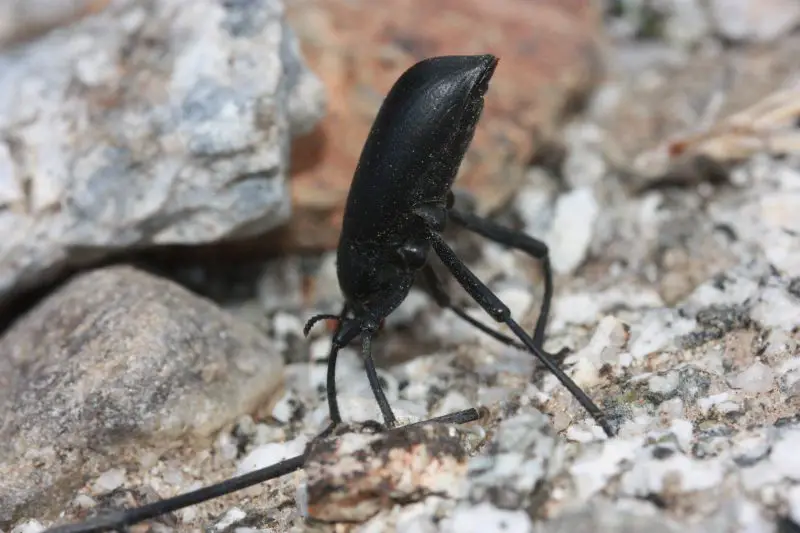
Darkling beetles in the genus Eleodes are large, black beetles often found in arid and desert regions of North America. They measure between 15 and 40 millimeters and have a robust, heavily armored body.
These beetles are primarily scavengers and detritivores, feeding on decaying plant matter, seeds, and fungi. When threatened, some species perform a defensive “headstand” posture, releasing a noxious chemical to deter predators.
Eleodes beetles are well adapted to dry environments such as deserts and scrublands, where they contribute to nutrient recycling by breaking down organic material.
Scarab Beetle (Scarabaeidae)
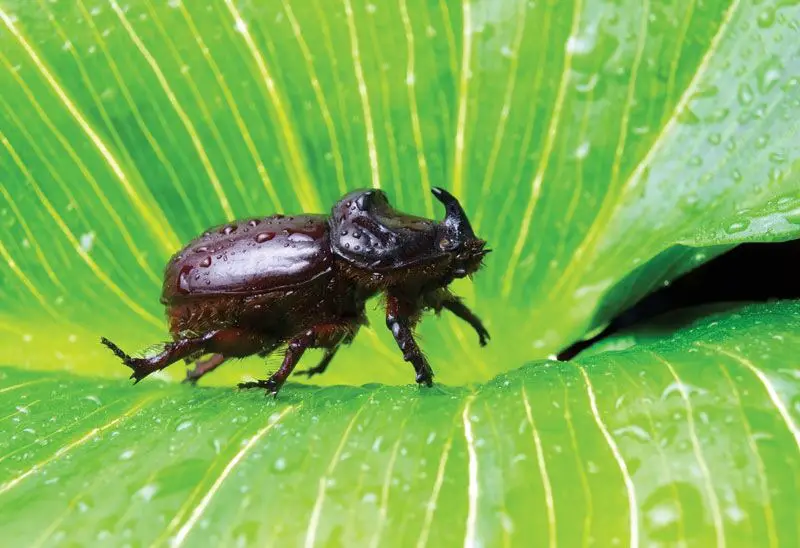
Scarab beetles are a diverse family ranging from small to large beetles, often brightly colored or metallic. Many species have distinctive lamellate antennae that can fan open. Their size varies widely, from a few millimeters to several centimeters.
Most scarab beetles feed on dung, decaying vegetation, or roots. Some are important decomposers, recycling animal waste, while others are pests of crops and turf. Adults may be nocturnal or diurnal and show various behaviors such as rolling dung balls or burrowing.
They are found worldwide in diverse habitats, including forests, grasslands, deserts, and agricultural areas.
Click Beetle (Elateridae)
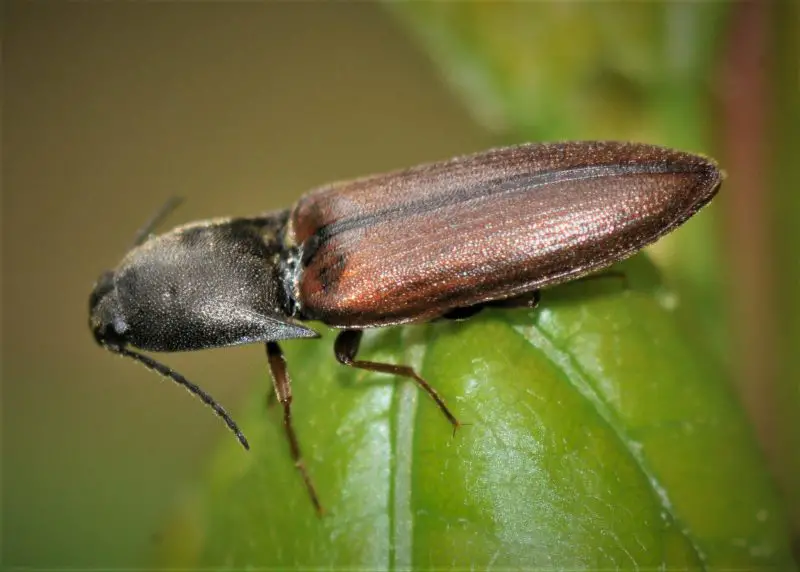
Click beetles are slender, elongated beetles typically ranging from 10 to 30 millimeters long, with parallel-sided bodies and serrated antennae. They are named for their unique ability to produce a clicking sound by snapping a spine on the underside of their thorax, which also helps them flip into the air.
Larvae, known as wireworms, live in soil and feed on roots and seeds, sometimes causing damage to crops. Adults feed on plant material or nectar and are mostly nocturnal.
Click beetles are widely distributed around the world, inhabiting fields, gardens, forests, and grasslands. They are most commonly seen after rain or at night when attracted to lights.
FAQs about Types of Beetle Insects
What are beetles and why are they important?
Beetles are insects with hardened wing covers and play vital roles in ecosystems, such as pollination, decomposition, and pest control.
How many types of beetle insects are there?
There are over 350,000 known species of beetles worldwide, with diverse shapes, sizes, and behaviors.
How can I identify different types of beetle insects?
Identification is based on size, color, body shape, antennae, and habitat. Our guide covers 45 common types with detailed descriptions.
Are beetles harmful to plants?
Some beetle species can damage crops and plants, but many are beneficial by controlling pests or recycling nutrients.
Where can I find beetles?
Beetles live in varied habitats including forests, gardens, fields, and even inside homes.


